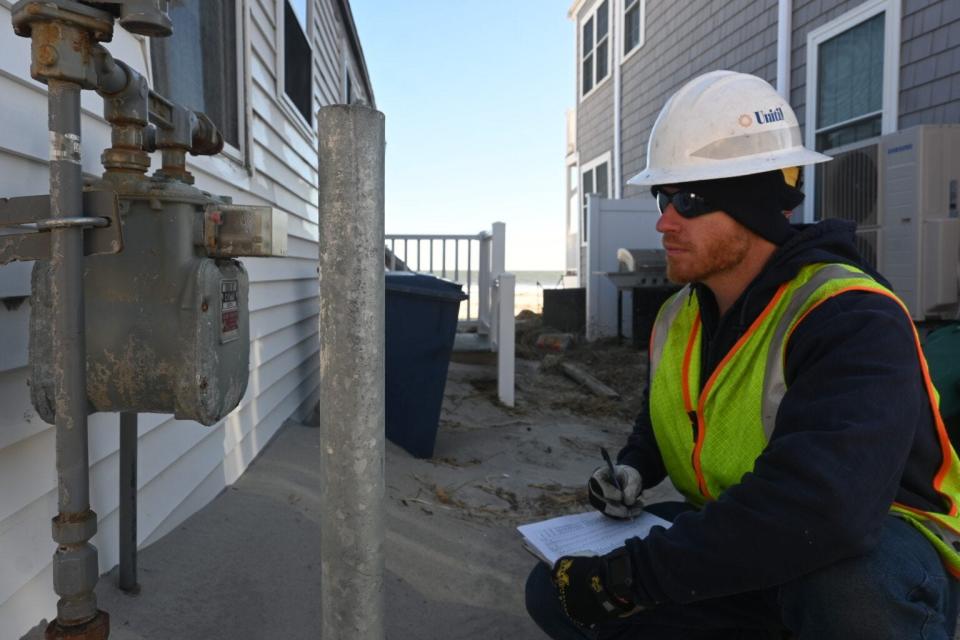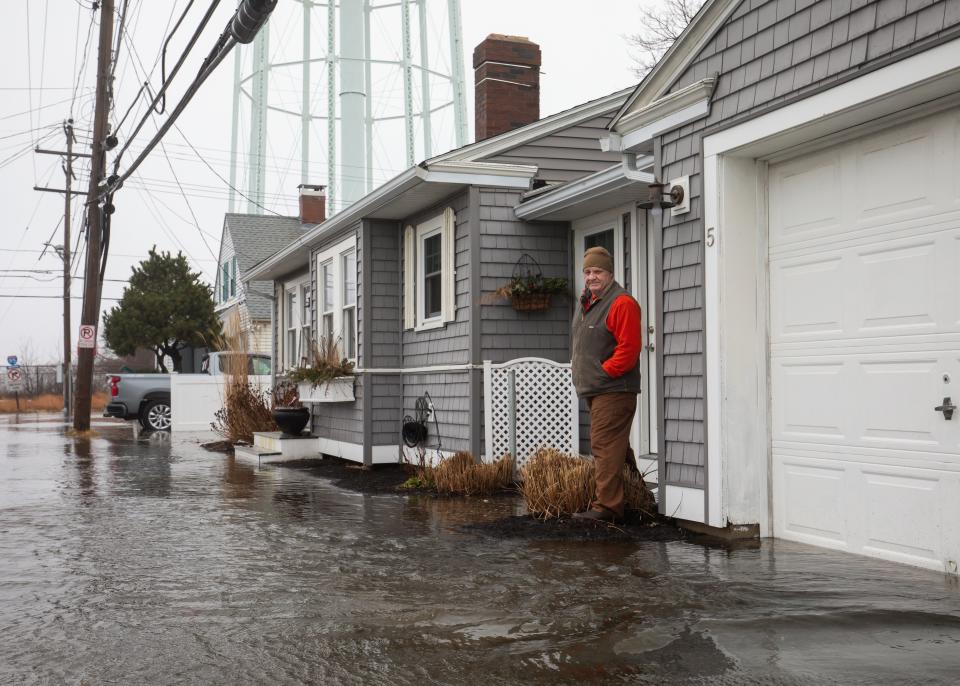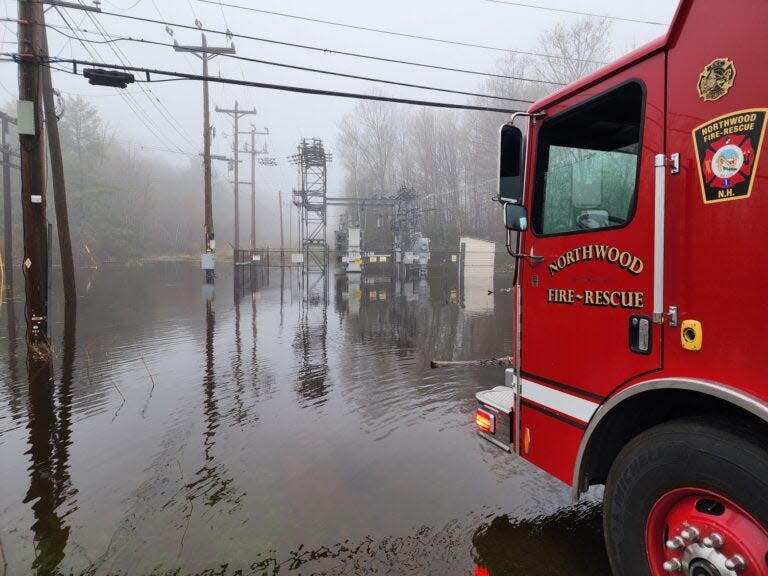Gas meters underwater: What Hampton Beach area floods mean for NH energy infrastructure
When historic high-tide flooding struck Hampton Beach on a Saturday in January, Unitil received reports of submerged natural gas service meters and regulators. Gas technicians decided to proactively conduct door-to-door inspections – approximately 3,000 meters were checked for damage.
As unprecedented flooding walloped the coast that day, Unitil warned customers about serious hazards, namely wet electrical wiring and gas service equipment. If someone suspected a gas leak, they were urged to call 911 and move to a safe environment.
While the gas system itself wasn’t directly impacted by the flooding, Unitil ultimately shut off about 100 meters that had sustained damage and required repairs or replacement.

The science of what actually happened on Jan. 13 isn’t settled – whether the area was due for a historic extreme weather event, akin to the Blizzard of ‘78, or if the storm was climate change-driven – said Jennifer Jacobs, professor of civil and environmental engineering at the University of New Hampshire. But what is certain is that high-tide flooding is becoming increasingly common due to years of sea level rise, scientists say.
For the utilities that provide residents and businesses with electricity and gas services, it’s an escalating reality they’re considering in their strategic plans. From substations, to transformers, to individual gas meters at homes, flooding and storm surge pose threats to energy infrastructure.
More: Sen. Shaheen: Seacoast storm damage expected to qualify for FEMA funds
“It’s very fair to say this will be a reference point event for us as we think about things like coastal flooding and what that means,” Alec O’Meara, external affairs director for Unitil, said about the Jan. 13 ordeal.
According to UNH research projections, between 2020 and 2099, the state can expect a twofold or threefold increase in extreme precipitation events. Sea levels are estimated to rise between 0.6 and 2 feet by 2050, and between 1.6 and 6.6 feet by 2100, depending on greenhouse gas concentrations.
During the back-to-back flood events on Jan. 10 and 13, municipal officials and coastal residents remarked they’d never seen storm impacts quite so bad. Seawalls were breached and destroyed, swaths of Route 1A were closed entirely, and handfuls of residents along Hampton Beach evacuated their homes.
“I was surprised not by which areas flooded, because we’ve mapped them out pretty well, but that these levels were levels I wasn’t expecting now,” said Jacobs, who studies flooding and its impact on coastal resiliency, infrastructure, and transportation.
The verdict is still out on the true cause of the extreme weather in January, and Jacobs said her colleagues at UNH are actively working on related research. Regardless, she said, the flooding serves as a grim harbinger.
“I think as a community, this is a wake-up call because with a changing climate, what this does is it shows us a little bit about what it would look like if the sea level was a couple extra feet higher,” Jacobs said.
Unitil’s response to Jan. 13 flooding
Unitil’s response efforts on the weekend of Jan. 13 were zeroed in on Hampton because it experienced the worst coastal flooding. The morning after the storm, the utility’s mobile emergency operations center was deployed and the door-to-door inspections began.
O’Meara said technicians were looking specifically at the gas meters and regulators at each individual home, both the “entry points” for gas service into a structure.
“Those need to be functioning properly for any of the appliances in the home to do what they’re supposed to do,” he said.

Of most concern is that submerged or partially submerged gas meters can leak or malfunction. If any natural gas equipment has been underwater, it shouldn’t be used until it’s been inspected by a professional.
The good news, O’Meara said, is the majority of inspections didn’t reveal damage – approximately 100 of the 3,000 meters inspected had to be shut off, and most of those impacted were back up and running by Tuesday of the following week.
The historic flood event reminded Unitil why it embarked on a company-wide climate scenario exercise during the summer of 2022, where employees took two possible climate change outcomes – varying degrees of warming – and applied them to their infrastructure.
Based on the analysis, O’Meara said, Unitil’s substations, poles, and transformers don’t appear to be significantly impacted, but the exercise underscored the need to be prepared for extreme weather that strikes unexpectedly, because the utility will likely find itself responding to outages more frequently.
“We’re going to be looking at what happened with the flooding on the beach and compare that to the modeling we did ahead of time,” O’Meara said. “Does it align with what we did? Do we need to change our strategic plan? Broadly speaking, based on the work we’ve done so far, we feel good about the infrastructure itself. The thing we need to plan for is how we make sure we have a robust emergency management system in place so that as more frequent storms occur, we are well-prepared to take those on.”
It’s not just the coast
Inland parts of the state have also experienced recent historical flood events, meaning it’s not just coastal infrastructure that’s at risk.
Last July, the Monadnock Region was pummeled by quick and heavy rain that led to washed-out, impassable roads and evacuations. That same rainstorm put much of the downtown area of Vermont’s capital city, Montpelier, underwater. Then, in December, New England was hit with another record-setting, powerful storm that saw rivers overflow in the North County and White Mountains.

Eversource spokesman William Hinkle said electric substations are one of their primary concerns when it comes to flooding – for “accessibility, reliability, and safety reasons.” Last May, one of the utility’s substations in Northwood experienced flooding, caused by a beaver dam in a culvert nearby after heavy rain. The substation was under about a foot of water, and the Northwood Fire Department had to bring in a pump truck to pull it from the site.
“Flooding can pose challenges for accessing our substations during storms, and if equipment is damaged, it could cause an outage for all customers served by that particular substation,” Hinkle said.
The state ultimately had to use high pressure hoses to break-up the dam in Northwood, and later installed a cage in front of the culvert. Eversource has been closely monitoring the situation in case the beavers return.
Hinkle noted flooding can also increase safety risks for Eversource crews that have to make repairs, ones that can be “much more time-intensive than the repairs to the distribution lines that most people are generally more familiar with.”
Eversource, the state’s largest electric utility, is performing a new flood study this year, having changed to a 500-year-flood risk assessment and design as opposed to a 100-year-flood design. That’s because 100-year floods are increasing in frequency.
In essence, a 100-year flood has a 1 percent chance of happening each year, while a 500-year flood has a 0.2 percent chance. According to a study from First Street Foundation, a research nonprofit that releases climate risk data, roughly 21 percent of the country can now expect their “1-in-100-year flood” to happen every 25 years.
This story was originally published by the New Hampshire Bulletin.
This article originally appeared on Portsmouth Herald: What Hampton Beach area floods mean for NH energy infrastructure

